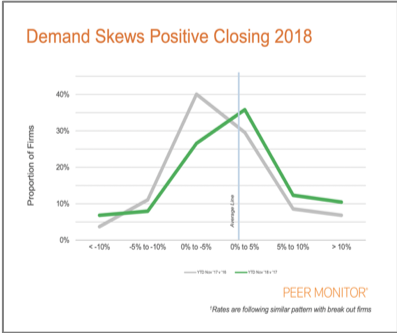Introduction
 In spite of recent stock market volatility and suggestions of economic slowing, we are entering 2019 with some momentum in the legal economy.[1] Industry data, like that from Peer Monitor, have reported modestly stronger organic demand growth and rate increases, all the while highlighting many familiar decade-long trends and issues: (1) wide dispersion of results from firm-to-firm, (2) volatility in year-over-year performance, (3) variance in performance firm-to-firm and apparent separation of the pack among high-end firms, (4) success and risk of lateral hires, (5) re-ignited associate salary wars after a few years of lull, (6) increased use of merger strategies to achieve scale and/or “success,” (7) new competitors and industry shift, and (8) a wide-ranging set of technology issues to ponder, from mundane data issues, to more exotic topics like predictive analytics and AI.
In spite of recent stock market volatility and suggestions of economic slowing, we are entering 2019 with some momentum in the legal economy.[1] Industry data, like that from Peer Monitor, have reported modestly stronger organic demand growth and rate increases, all the while highlighting many familiar decade-long trends and issues: (1) wide dispersion of results from firm-to-firm, (2) volatility in year-over-year performance, (3) variance in performance firm-to-firm and apparent separation of the pack among high-end firms, (4) success and risk of lateral hires, (5) re-ignited associate salary wars after a few years of lull, (6) increased use of merger strategies to achieve scale and/or “success,” (7) new competitors and industry shift, and (8) a wide-ranging set of technology issues to ponder, from mundane data issues, to more exotic topics like predictive analytics and AI.
In his October blog post, my colleague Joe Altonji described the progress made in the industry over the decade since the credit crisis hit. In it, he cited three major areas of improvement including (1) better client listening practices, (2) improved cost management, and (3) increased sensitivity to generational shifts in talent management and leadership structure.
Notwithstanding the economics and the progress made by firms, in our conversations with law firm leaders, we hear frustration. There is a feeling that much more must be done by firms to act differently, while battling the inertia that has built up through decades of success that is tied to a rapidly declining yet still highly-defended and protected business model.
The belief is that right-sizing and the drive towards greater efficiency must continue but won’t be enough. More troubling is the perception that technology is more complicated (arguably true) and expensive (increasingly not correct), creating a hyper-competitive operating environment where successful strategy is unclear and may require an out-of-reach budget. This landscape and some of its basic assumptions confound many leaders.
Digital World Implications
This blog examines these ideas in the context of our digital world and a firm’s strategy. Digital strategy is the idea that our competitive environment is being transformed through the increasing use of data and digital applications, and that any firm must factor it into their strategic plans. It doesn’t say one should digitize everything, but rather a firm should think about how it affects its competitive position. It is meant to offer some perspective on how to proceed. For starters, consider these thoughts:
- The client remains king, but the king is smart and getting smarter. Sound business management principles remain the same. Peter Drucker once said that “the purpose of a business is to create a customer.” That doesn’t go away, but in fact only intensifies in a digital world. The client will use data to understand and evaluate its service providers better, to bring work in-house when appropriate, and to illuminate new ways to solve existing problems faster and with higher quality.[2]
Take away: You need to have a digital strategy to at least align with your client who will expect it, new talent who will want it, and your performance models, which will require it.
- Competition will increasingly be varied, and barriers to entry will be lower. A digitized marketplace features both heightened competition and increased competitive risks. While this phenomenon has implications for firms, it invites thoughtful questions about size, scale, structure and commercial models. It also opens doors to competitors from outside the industry that may possess a much different set of capabilities, styles, or breadth in services, providing them competitive advantage.
Take away: Find your niche and competitive moat in the digital realm. In some cases, it may be scale, in others deep expertise, technological sophistication, etc. All competitors will use technology and data to compete. Smaller players should have the advantage of agility while larger players may have the advantage of scale.
- Data will play an increasingly important role in the success of the firm. In “Why Software is Eating the World,” published in the Wall Street Journal back in 2011, Marc Andreessen described how data and digital work streams are becoming the heart and soul of many companies. He cited various now well-worn examples: the largest lodging company doesn’t own buildings (AirBnB), nor the largest transportation company own cars (Uber), and other areas like telecom (Skype), are being similarly transformed. His point was that data will impact all industries; it sometimes is referred to as “oil for the 21st century.” There have been numerous articles written in recent years about the pending disruption to legal services — even one written by the king of disruption himself, Clayton Christensen, in his 2013 Harvard Business Review article entitled, “Consulting on the Cusp of Disruption.” In Christensen’s article, legal is hailed as a case study where technology is enabling new types of competitors, disaggregating legal services and increasing their commoditization while creating a more transparent marketplace.[3]
Take away: Legal will change and we should be constantly thinking about that, but it won’t be radically different in 2019, so aggressively plan for the future while optimizing for the present. Use digital technologies to advance important client goals, drive efficiency, and maximize profitability.
The effective use of data doesn’t change strategic fundamentals but introduces a couple of new ideas: (1) that a digital element must now be factored into the future thinking about where the firm wants to go to meet the needs of external and internal stakeholders, and (2) that the world is becoming significantly more fluid, so your strategy is likely to be outdated at a much faster rate than the past. The need to revisit it, (re)test your underlying assumptions and pivot will be more frequent than ever.
Digital Strategy Progression
If all this seems daunting, consider that most firms are just getting started. Once in motion, the ability to learn and accelerate increases significantly. Below is a chart that may provide guidance for where a firm stands with regard to its digital execution, and a roadmap for taking next steps in light of the larger vision.
 © Copyright LawVision 2018-2019. All Rights Reserved.
© Copyright LawVision 2018-2019. All Rights Reserved.
Data Design and Action
There are many conceptual diagrams about how best to think about and use data. Think of data as an asset to be managed and measured with the goal to maximize its return. Maximizing value translates into broad active use and benefit, which leads to a discussion of how to best get data into the workflow and activities of the firm. A report sitting on the shelf or only known to one analyst is worth substantially less than data guiding the firm on client management, pricing, profitability, matter management, or case assessment.
Today, most data experts classify data insights into three groupings: descriptive, predictive, and prescriptive, which is further described in the chart below published by McKinsey.
 Source: McKinsey, An Executive’s Guide to AI
Source: McKinsey, An Executive’s Guide to AI
Applying these ideas to legal might produce the following kind of table as seen here.
Review These Areas in 2019 Related to Digital Strategy
Notwithstanding the bold predictions by Christensen and many others regarding dramatic disruption of the industry, we must manage for 2019 with an eye towards the future. We have heard concerns from leaders on the topics listed below as priorities for the upcoming year:
- Re-balancing the firm to match its economic reality
- Considering new ways to better connect with and serve clients
- Improving the firm’s pricing position
- More systematically managing profitability
- Creating a performance culture
- Attracting, retaining and developing talent.
Technologically, firms are grappling with
- The meaning and pragmatics of innovation
- Using data as the underpinnings for decision-making and prediction
- Researching advanced ideas like AI as they pertain to the practice of law
- Managing the pace of change driven by technology.
In closing, as we look forward to the new year and far beyond, we see many issues on the horizon that will compete for the attention of law firm leaders, many of which will be better managed with a strong digital strategy. This blog intends to offer leaders a structure to think about digital trends in a simple way that can provide context, help set priorities and be a guidepost for decision-making. In follow-up articles, we will discuss more in-depth approaches to using data and analytics in support of the range of important topics of the day, all in the spirit of driving productive change.
_________________________


